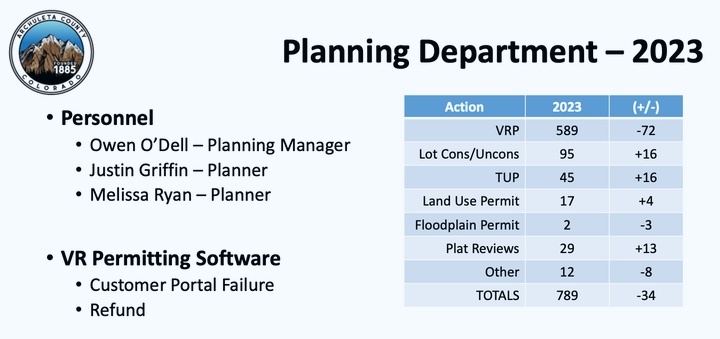“We are concerned about the state’s chatter about pushing us to adopt the 2021 Energy Code. So Tim and I have both bought the copies of that code and we’re starting to review it, to see where we might want to recommend amending that code, if we’re forced to adopt it — what portions we would suggest amending out, based on the potential impact to building costs.
“So Tim and I are starting to dig into that…”
We’re listening, here, to Archuleta County Development Director Pam Flowers during her semi-annual update to the County Commissioners on March 19. She’s referring to her Building Official, Tim Hatch, and to the International Code Council’s document — the 2021 International Energy Conservation Code, which addresses energy efficiency on several fronts including cost, energy usage, use of natural resources and the impact of energy usage on the environment.
It’s a double edged sword.

Homes and offices and other types of buildings consume about half of the energy used in the U.S. — electricity and fossil fuels — and about one-third of that energy is used for heating and cooling. Another third is used for lighting. The average amount of energy used per square foot has declined over the past couple of decades, but the number of buildings has increased.
The International Code Council — affectionately known as the ICC — is a nonprofit standards organization that writes model codes for various types of construction. The International Building Code (IBC) applies to commercial buildings, the International Residential Code (IRC) applies to homes, and the ICC has created several other model codes, among which we find the ‘IECC’: The International Energy Conservation Code. The general idea is that certain materials and building techniques can reduce the amount of energy a building consumes, and thus reduce America’s dependence on Exxon Mobil, Chevron, Black Hills Energy, Tri-State Generation, Xcel Energy, and so on… the companies that make huge profits off our energy consumption.
By keeping inside air inside, and keeping outside air outside, we can reduce our dependence on these companies. In theory.
The other edge of the sword? Increased building costs, and natural lack of fresh air. These two unfortunate side effects of airtight construction are a point of contention in 2024. Are we ruining our health, and draining our pocketbooks, when our local governments adopt the latest Energy Code?
Archuleta County is not currently required to adopt the model Energy Conservation Code, but might be required to, in the near future. Typically, a government can choose to void certain requirements, by adopting an amended version of the code.
Ms. Flowers:
“One great example of what’s in that code, is that it requires a ‘whole home pressurization test’ for every build. That will be very expensive and prohibitive for a lot of folks. Those are the kinds of things we can look at, and amend out…”
Commissioner Ronnie Maez:
“What’s the pressurization test supposed to prove?”
Tim Hatch:
“It’s called a ‘blower door test’… They literally take the front door off, put a plug in the doorway, and run a huge fan… and they test the pressure of the house…”
Is the whole house leaking air at too fast a rate? Then your house will fail the test.
“Yes, and it’s not necessarily the test that gets expensive. It’s trying to make the house or building pass the test, that can get brutally expensive.”

Commissioner Maez:
“I think homes are better when they breathe.”
Mr. Hatch:
“Absolutely. 100%. And that’s a huge fight right now, between the IECC and the IRC. The 2024 Code is supposed to be out already, but the IRC [group] do not agree with the IECC [group] because they’re making the buildings so airtight that they just don’t breathe.”
Ms. Flowers:
“The 2024 Code hasn’t been released because of this dispute between the IRC group and the IECC group… Hopefully the state will say, if we have to use the 2021 Code, they will give us the flexibility to amend out the things we need to…
“But they could also say we have to accept it 100%. The state can say whatever they want, and then we have to figure out how to maneuver that. We want to be prepared — hopefully, they give us some flexibility — so you guys can be informed about the impacts of that code…”
Commissioner Maez:
“It’s going to be interesting.”
Mr. Hatch:
“It could be an extraordinary impact to the cost of building.”
Commissioner Maez:
“To the cost of building, and I also don’t think it’s a super healthy thing to live in an airtight house.”
Mr. Hatch:
“Yeah, there’s a lot of controversy about that. But there are ways to offset it. You use heat recovery ventilators. and energy recovery ventilators. But all that just adds additional cost… and your electricity bill goes up. It’s crazy. They are making these [buildings] super airtight, for energy efficiency, but now they’re so airtight, you have to bring in all the cold air from outside, and try to heat it…”
Ms. Flowers:
“It’s complicated, that’s for sure.”
Ms. Flowers then gave an overview of the Planning Department, where some of the biggest challenges appear to be with vacation rentals, and especially, with with software the County purchased to help handle STR enforcement and permitting. The software developer apparently promised to add a ‘customer portal’ — two years ago. And has yet to deliver on that promise.

As we can see in the slide Ms. Flowers shared,”VRP” [Vacation Rental Permits] make up the lion’s share of the work in the Planning Department.
She hopes to get a refund for the permitting portal software that never worked properly, and use the money to purchase a module from a different software company that will link all permitting and approval processes together.
“In next year’s budget — I can’t do it this year because I didn’t include it in our budget — but in next year’s budget, I’m going to add an online complaint system that will automatically create those cases for us, when people file a complaint for anything…”
A smoother complaint system.
That should make life better.

